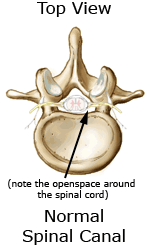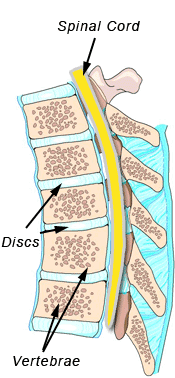(512) 261-8699
Lumbar Stenosis

Your spine, or backbone, protects your spinal cord and allows you to stand and bend.
Spinal stenosis causes narrowing in your spine.
The narrowing puts pressure on your nerves and spinal cord and can cause pain.
Spinal stenosis occurs mostly in people older than 50.
Younger people with a spine injury or a narrow spinal canal are also at risk.
Diseases such as arthritis and scoliosis can cause spinal stenosis, too.
Symptoms might appear gradually or not at all.
They include:
Spinal stenosis is the narrowing of the spinal canals.
It may involve the central canal, the hollow tube on the backside of the spine through which the spinal cord travels, and/or the transverse foramina, the canals from which the spinal nerves exit.
Narrowing of the spinal canals is usually an age related process (called secondary stenosis).
During this process the vertebral discs lose their height (degenerate), the ligaments become stiff, and bone spurs may form.
The combination of loss of disc height, hardening of the ligaments, and bone spur formation can cause the stenosis.
Other conditions such as spondylolisthesis, trauma, or post-surgical complications, can also cause stenosis.
Because of mechanical compression and blood flow congestion, spinal stenosis can result in severe pain.
With lumbar or low back spinal stenosis, symptoms often include low back pain and a diffuse radiation of pain into the buttocks and thighs. Tingling and numbness and leg weakness may be present as well.
Symptoms are often worse with standing, walking, and backward bending/extension of the spine.
Sitting, forward bending, and unweighting of the body often provide relief.
One of the hallmark signs of lumbar spinal stenosis is a decreased walking tolerance.
Conservative care (rehabilitation), may be helpful. Treatment may consist of stretching, strengthening, joint mobilization/manipulation, aerobic exercise, and activity modification.
Walking with an "unweighting system" or aquatic exercise may be helpful.
It is important to work closely with your physician and physical therapist.
Spinal stenosis causes narrowing in your spine.
The narrowing puts pressure on your nerves and spinal cord and can cause pain.
Spinal stenosis occurs mostly in people older than 50.
Younger people with a spine injury or a narrow spinal canal are also at risk.
Diseases such as arthritis and scoliosis can cause spinal stenosis, too.
Symptoms might appear gradually or not at all.
They include:
- Pain in your neck or back
- Numbness, weakness, cramping, or pain in your arms or legs
- Pain going down the leg
- Foot problems
Spinal stenosis is the narrowing of the spinal canals.
It may involve the central canal, the hollow tube on the backside of the spine through which the spinal cord travels, and/or the transverse foramina, the canals from which the spinal nerves exit.
Narrowing of the spinal canals is usually an age related process (called secondary stenosis).
During this process the vertebral discs lose their height (degenerate), the ligaments become stiff, and bone spurs may form.
The combination of loss of disc height, hardening of the ligaments, and bone spur formation can cause the stenosis.
Other conditions such as spondylolisthesis, trauma, or post-surgical complications, can also cause stenosis.
Because of mechanical compression and blood flow congestion, spinal stenosis can result in severe pain.
With lumbar or low back spinal stenosis, symptoms often include low back pain and a diffuse radiation of pain into the buttocks and thighs. Tingling and numbness and leg weakness may be present as well.
Symptoms are often worse with standing, walking, and backward bending/extension of the spine.
Sitting, forward bending, and unweighting of the body often provide relief.
One of the hallmark signs of lumbar spinal stenosis is a decreased walking tolerance.
Conservative care (rehabilitation), may be helpful. Treatment may consist of stretching, strengthening, joint mobilization/manipulation, aerobic exercise, and activity modification.
Walking with an "unweighting system" or aquatic exercise may be helpful.
It is important to work closely with your physician and physical therapist.
